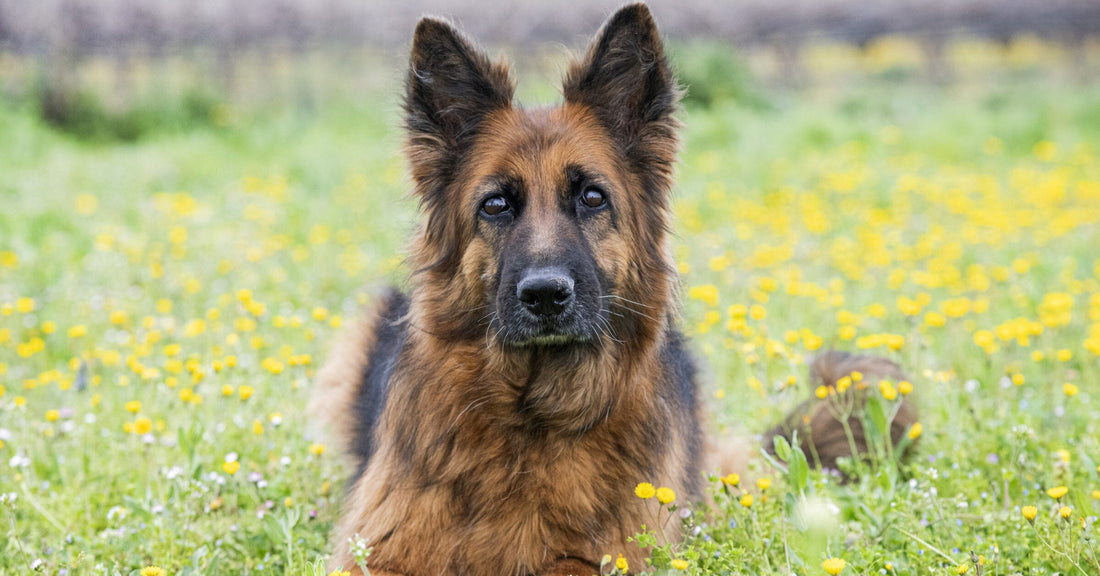German Shepherd Vocalizations: Interpreting Barks, Whines, And Growls To Understand Your Dog's Communication

German shepherds communicate using their senses, such as sight, smell, and sound. Their body language, glandular secretions, pheromones, and vocalizations all play a part in how they exchange information with other dogs and people.
If you’ve ever noticed your German shepherd watching you, you might be observing your dog reading your body language. At times, it seems as if they’re mind readers when in fact they are interpreting and anticipating your non-verbal cues and responding to them.
Learning to read your dog’s body language is an important skill for you to have. It can help you determine what their state of mind, emotions, and health status is. Understanding what their posture, stance, tail position, facial expressions, ears, and more are saying is crucial to understanding mood and behavior.
Another way dogs communicate is through vocalizations. Coupled with body language, vocalizations are a powerful tool dogs use to communicate. Although vocalizations may not be as significant as body language, listening to what your dog has to say is useful in interpreting their needs and emotional state. Some ways dogs vocalize include:
Barking
Barking is a very common behavior for dogs. It’s one of the ways they communicate with other dogs and people. There are many reasons why dogs bark, including when they are:
• Alert German shepherds are herding dogs and are very aware of their surroundings. They will often issue an alert when they notice something unusual or potentially threatening. The sound of the bark will be repetitive, and deep, and their body posture will be tense with their eyes focused on whatever they’re barking at.
• Playful-Playful barks are usually high pitched (more like a yip) and are used when they want to play or are feeling excited about something, such as asking for a treat. Playful barks are accompanied by relaxed body posture.
• Anxious-Often is a sharp, quick bark that indicates confusion, discomfort, or fear in response to uncertainty, stress, or a perceived threat. Their body language will not be playful.

• Fearful- When dogs are fearful or distressed, they may bark repetitively in a high-pitched tone. They may have a tense body posture and even wag their tail.
• The saddest of the barks may happen when your dog is left alone or they are asking for attention and not getting it.
• Bored/Nuisance-Continuous monotone barking may be a form of boredom or nuisance barking. This type of barking may be a sign that the dog has a problem that needs to be addressed, that your dog has anxiety or behavior problems, or their needs are not being met.
Whining
Whining is another common way dogs communicate. Dogs will whine for many reasons, including when they are:
• Seeking Attention-Dogs may whine in a high-pitched tone to get attention, when they want to play, because they need to go outside, when they want food, or desire some extra attention.

• Anxious-Continuous whining usually indicates anxiety or discomfort, such as when a dog is separated from their owner or left in an uncomfortable situation.
• In Pain-Dogs may mournfully whine when they are in pain or discomfort due to injury or illness, coming out of anesthesia after a medical procedure, or experiencing great sadness.
Howling
Howling is another sound dogs make, which some believe is a dog's way of saying, “Here I am” to other dogs and people. Dogs will often howl when they are:
• Lonely-Dogs may howl when they're feeling lonely or anxious or are locked up, such as when they’re separated from their pack, which could include their owner or other dogs.

• Excited dogs may howl when they're excited, such as when greeting their owner after a long absence.
• Responding to Sounds- Some dogs will howl in response to certain sounds, such as sirens or a song.
• In Pain-A dog that is unusually howling and can’t be comforted may be sick or in pain.
Growling
Growling is a form of communication that should always be interpreted with body language since it has many meanings, such as when they are:

Warning/Guarding-A guttural, low, warning growl is a dog’s way of saying, “back off” or I might bite. A dog may issue a warning growl when they are distressed, in pain, responding to a threat, or feeling stressed. Their tense body language and facial expressions will also send a warning message.
Playful-A certain times, dogs may growl when they are feeling playful. In those moments, their body posture will be relaxed, they may be wagging their tail, or even using play bows.
Pleasure-Dogs may growl in response to pleasure, for example when they are getting a belly rub or stretching.
Yelping
High-pitched yelping is less common than barking and can happen for many reasons, such as:

• Pain/Injury-Sudden, sharp yelps can signal a dog is experiencing pain or has been injured.
• Surprise-Some dogs will yelp when taken by surprise or startled. Unlike with pain or an injury, normal behavior and tail wagging usually quickly follow.
• Fear-Dogs may also yelp when they're frightened by something in their environment.
• Need Attention-Some dogs will yelp when they urgently need attention. For example, they may need to immediately go outside to take care of business.

Sighs and Groans
Just like people, dogs sigh and groan. Some reasons they may do this include showing:
• Disappointment-A dog may express disappointment by sighing and groaning. For example, a dog might flop down and groan or sigh when they don’t get to go for a walk or play with a toy.
• Contentment-A dog may communicate they are content by groaning, such as they lay down to take a nap or after eating a meal.
Understanding your dog's unique vocalizations, along with their accompanying body language, can provide you with insight into their emotions and help you better anticipate their behavior.
By getting to know your dog’s unique forms of communication, you can improve training, help strengthen the bond you share, and it will help you to be even more aware of subtle changes in their health status and mood.

If you're ever unsure about the meaning behind your dog's vocalizations or they have a sudden change in the way they communicate, it may be a good idea to see your vet to rule out any health problems.
We hope you enjoyed this article. As always, please feel free to share with your friends.
You might also like: The German Shepherd's Nose Knows: Harnessing Scent Work for Mental Stimulation
























